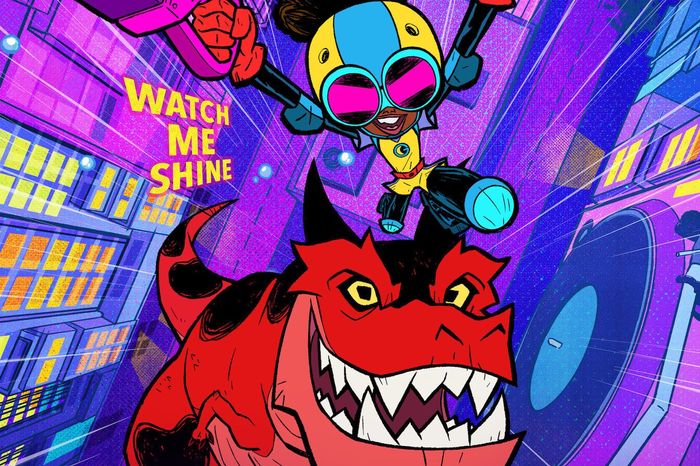
A lot of kids’ TV is garbage. The animation’s shoddy, the jokes are hacky, and the lessons are nonexistent. The fights can seem gratuitous, the music can grate, and they’re often wrapped in a kind of plush, cheery worldview that’s not just boring but also unrealistic.
That’s why Marvel’s Moon Girl and Devil Dinosaur is so refreshing. A show about a 13-year-old STEM savant living on the Lower East Side who summons a friendly T. rex from a different dimension and becomes a tech-powered superhero, the animated series is charming and chic, funny and heart-wrenching. It’s full of girl power and science snippets that are actually educational, and it’s all wrapped in a soundtrack curated and created by Raphael Saadiq. It’s one of the coolest kids’ shows airing right now, and it’s also one of the most inspiring.
Originally created by Brandon Montclare, Amy Reeder, and Natacha Bustos, Moon Girl (a.k.a. Lunella Lafayette) first appeared in a Marvel comic in 2015. Then written as a 9-year-old Haitian American girl who discovers she carries the Inhuman gene, Moon Girl was envisioned as a sequel to Jack Kirby’s Moon-Boy and Devil Dinosaur series, which was about an ape boy and his supersmart dino friend and dropped in the ’70s to fairly minimal acclaim. About 50 Moon Girl comics were published before the series wrapped in 2019 with audiences falling in love not just with the hero’s whip-smart intellect and supercool gadgets but also with the realistically diverse and intriguing world that Montclare, Reeder, and Bustos created for her to inhabit.
Moon Girl the TV show came into existence when actor Laurence Fishburne — who had just appeared in Marvel’s Ant-Man and the Wasp — fell in love with the comic after being gifted a copy by studio president Louis D’Esposito. He teamed up with producers and worked to hire a production crew that was almost entirely made up of women, people of color, and members of the LGBTQ+ community. Input from everyone on staff was encouraged, and the showrunners worked to not only get Moon Girl right but also to capture the richness of her community, her experiences, and the characters around her, from her social-media-obsessed best friend, Casey Calderon (whose two dads are played by Andy Cohen and Wilson Cruz), to her kind and creative grandma, Mimi (Alfre Woodard), who comes to play an especially important role near the end of season one.
Lunella’s world is full of grit and wonder, and in the show, her superpowers aren’t the result of some mysterious genetic mutation but rather a product of her wild intelligence, supreme curiosity, and supportive community. She’s a whiz in the lab, whipping up gadgets at a speed that would make Tony Stark jealous, but she’s also just a kid, dealing with the stresses of school, her family’s economic situation, and an online troll who says she’s got a fivehead. Her natural hair pops out of her yellow-and-purple superhero helmet in puffs, and she fights gentrification while whipping around Delancey Street on her classic roller skates.
Moon Girl is also incredibly likable in a way that’s aspirational for all kinds of kids. Moon Girl and Devil Dinosaur isn’t just a show that supposedly teaches girls about the power they have inside. It’s for the boys who think they just want to watch good guys and bad guys scuffle, nonbinary and trans kids who yearn to see themselves onscreen, and kids with an encyclopedic knowledge of the Marvel multiverse. (With winking celebrity cameos, gags about cassette players, and surprisingly catchy tunes, it’s for parents, too.)
I fell in love with Moon Girl and Devil Dinosaur after my kindergarten-aged kids somehow stumbled onto it. I walked in when they were a couple of episodes deep, and my husband looked at me and said, “Have you seen this? It’s great.” There’s something inherently charming about the comic and Pop Art–style animation, which has notes of Into the Spider-Verse without becoming a direct copy, and I love the way the show cloaks its action sequences in more of a primary-colored veil, making the whiz-bang punches and kicks not only speed by but also seem less overwhelmingly scary for your more sensitive tykes.
The show also explains complicated issues in a way that kids can understand, relaying stories about the economic impact of blackouts on small businesses with the same authority that it talks about black holes and the singularity. In season two, there’s an episode in which Lunella ventures out into the desert to meet her grandma’s two best friends, Merle and Matsuye, and the trio of older women are written with such wit, vitality, and superintelligence that it calls into question basically every onscreen portrayal of senior citizens, save maybe The Golden Girls.
But Moon Girl and Devil Dinosaur is like that, really. In a world of kid shows and superhero dreck where you can pretty much always guess what’s coming next, Moon Girl is always twisting and bending the form, creating stories, worlds, and characters in a way that makes you question why every other show isn’t doing it just as well. Both on- and offscreen, Moon Girl reminds us that a better world is possible. We just have to work together to bring it to life.

